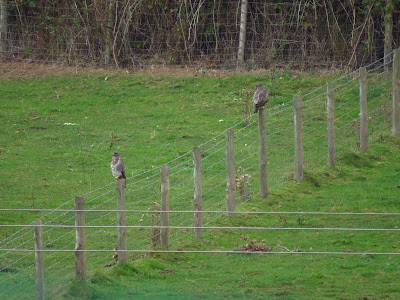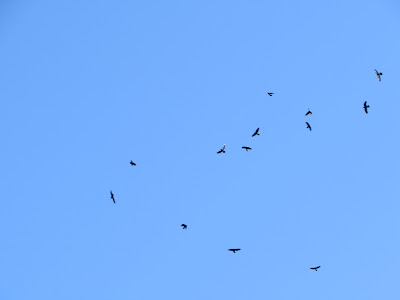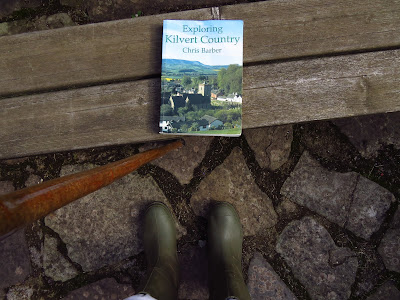To mis-quote Jane Austin "It is a truth universally acknowledged, that a single crow in possession of a good feeding area, must be in want of a flock."
I've been watching birds feeding this week.
 |
| As the rooks fly off, the carrion crow remains |
A superior position of not working this week means time and leisure to observe wildlife without the spectre of timescales looming over the horizon. My horizon most mornings has been the field beyond the house. This year maize has been grown in these 60 acres to feed cattle on the farm nearby. That farm is a haven for birds due to it's semi derelict buildings and overwintering cattle by the River Banwell. This week however I have been observing the antics of a mixed corvid flock taking advantage of spilt corn following the harvest of this wind pollinated fodder crop.
Before this, last week on holiday in Bredwardine in Herefordshire, I spent a lot of time watching a pair of buzzards feeding on the hillside at the back of the holiday cottage. When I say a lot of time, over 3 hours.
 |
| Buzzards feeding in Herefordshire |
It was Julie my wife who first spotted a single buzzard as it lazily flew off its fence perch to grab something in the field. Soon this paler bird was joined by a bigger and much darker bird. Buzzards like most raptors do exhibit sexual dimorphism, or strictly speaking reverse sexual size dimorphism, whereby the female is larger than the male. However this is not that marked in buzzards and so in field situations I can only guess the darker bird was the female of a pair. What was more interesting was their feeding behaviour.
 |
| Male and female pair? Maybe! |
Buzzards feed on an eclectic list of prey items from lagomorphs to birds, amphibians, rodents and carrion with insects and earthworms making up just a small but important percentage of their diet. An interesting study from 1993 revealed rabbits make up the bulk of a buzzard diet. Yet these two birds were feeding on worms and beetles. For all birds, diet composition changes with the passing seasons and weather. I remember years ago passing a field near Yeovil in Somerset containing 20-30 buzzards, all feeding on earthworms and invertebrates. I never saw them there again.
As with my Yeovil encounter, in Herefordshire the day before had been very wet indeed, presumably pushing the worms up to the surface. As the pair sat motionless on posts, every ten minutes or so one would float down to the ground pick up a worm, or insect too small to identify, eat it, and return to the post. This cycle of patient observation, followed by brief feeding repeated itself all afternoon until dusk. There can not be much nutrition in a worm, compared to say a vole, so their patience may have been out of necessity, rather than choice. That I don't know, for I stopped watching them after over three hours, but popping out as the last rays of sunshine filtered across the field, they were still there patiently watching and waiting. That buzzard pair, other than being together, were not co-operating in any specific feeding behaviour. Corvids however do.
 |
| Bredwardine pre roost |
The cottage boasted a summerhouse in the garden which afforded superb views up the Knoll which allowed me to sit in comfort observing the buzzards. A more noticeable event on first arriving at the cottage was the noisy mixed flock of jackdaw and rook. Each evening they did the same thing to form pre-roost groups, illustrating the sociability of these black birds. In Mark Cocker's Crow Country he talks about the [roost] "... one a shared stillness, the other a chaos of flight and noise. They pitch each individual bird towards the collective heart" It is a good description. Each evening at 5.30pm I'd hear the jackdaws first. Jak jak jak as they flew in over the cottage, three would land on the chimney, no more, no less. Soon the flying jacks would be joined by the craa craaa craa of the rooks as they formed a sizeable mixed species aerial display overhead. I never found out exactly where they went to roost each night, but their pre-roost antics, two species as one, were as regular as clockwork. Both species will roost together, during the day, rooks and jackdaws forage together for a very simple reason. Rooks have pickaxe bills ideally suited to digging deep into soil. Jackdaws having much smaller, slender bills, follow in the rooks wake and pick up the pieces. Some studies suggest rooks leave a proportion of their finds for the jackdaws and in return as jackdaws are more observant, the rooks gain additional security when out in exposed fields digging away.
Back home, this corvid sociability has taken itself to a new high in my knowledge, something I've not observed before. In the picture below, three species of corvid are on the wires overlooking the now harvested maize field, rook and jackdaw, but also carrion crow. Older books will tell you that a carrion crow is not a social bird. But over recent years my own observations are that while they are isolated and solitary in the breeding season, come autumn I see all three species in fields. Carrion crows are superb at security as they are ever watchful of threat and almost impossible to get close to. They will feed with rooks in the winter and out the back of the house I witnessed a repeated bit of behaviour I'd not witnessed.
 |
| Rook and jackdaw on wires, with single carrion crow fourth from left |
Much like the buzzards, this mixed corvid flock which numbered about 50 or more sat for a while on the wires. At a given moment, four or 5 birds, normally rooks would fly down to the field, frustratingly out of sight due to the hedge. In most cases a 10 second gap would occur. Jackdaws then followed with the remaining rooks in a maelstrom of activity, leaving (usually but not always) a carrion crow or two on the wires. The latter always seemed to be the last to fly down, either out of timidity joining this multitudinous flock of noise. Or as I like to think, the crows are the flock sentries keeping an eye out for predators, until when the whole flock is settled on the field, they too can flop down and join them to feed. In reverse or if disturbed, the rooks would fly up first, jackdaws next and bringing up the rear, the carrion crows.
I've witnessed this many times over the week. Always in the morning and by eleven o'clock all three species have flown off elsewhere to feed. All in all it has been a fascinating week observing common species but taking time to really watch what is happening. I still have a number of question in my head as to what is going on, time then to head off and observe this all over again.


























